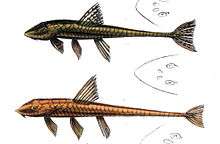Loricariichthys
Loricariichthys is a genus of catfishes (order Siluriformes) of the family Loricariidae.
| Loricariichthys | |
|---|---|
 | |
| Loricariichthys anus | |
| Scientific classification | |
| Kingdom: | |
| Phylum: | |
| Class: | |
| Order: | |
| Family: | |
| Subfamily: | |
| Tribe: | |
| Genus: | Loricariichthys Bleeker, 1862 |
| Synonyms | |
| |
Taxonomy
This genus is part of the Loricariichthys group within the subfamily Loricariinae; this group also includes the genera Furcodontichthys, Hemiodontichthys, Limatulichthys, and Pseudoloricaria.[1] Loricariichthys seems to be intermediate between Limatulichthys and Pseudoloricaria on one hand, and Furcodontichthys and Hemiodontichthys on the other.[1] Although this genus is well diagnosed, the species are very similar and difficult to identify.[1]
Species
There are currently 18 recognized species in this genus:[2]
- Loricariichthys acutus (Valenciennes, 1840)
- Loricariichthys anus (Valenciennes, 1835)
- Loricariichthys brunneus (Hancock, 1828)
- Loricariichthys cashibo (C. H. Eigenmann & W. R. Allen, 1942)
- Loricariichthys castaneus (Castelnau, 1855)
- Loricariichthys chanjoo (Fowler, 1940)
- Loricariichthys derbyi Fowler, 1915
- Loricariichthys edentatus R. E. dos Reis & E. H. L. Pereira, 2000
- Loricariichthys hauxwelli Fowler, 1915
- Loricariichthys labialis (Boulenger, 1895)
- Loricariichthys maculatus (Bloch, 1794)
- Loricariichthys melanocheilus R. E. dos Reis & E. H. L. Pereira, 2000
- Loricariichthys microdon (C. H. Eigenmann, 1909)
- Loricariichthys nudirostris (Kner, 1853)
- Loricariichthys platymetopon Isbrücker & Nijssen, 1979
- Loricariichthys rostratus R. E. dos Reis & E. H. L. Pereira, 2000
- Loricariichthys stuebelii (Steindachner, 1882)
- Loricariichthys ucayalensis Regan, 1913
Distribution

Loricariichthys is distributed in most major freshwater drainages east of the Andes and north of Buenos Aires.[3] Loricariichthys is widely distributed in the Amazon basin, the Paraná system, and coastal rivers of the Guiana and Brazilian Shields.[1]
Description
An accessory respiration organ, consisting of a double respiratory purse connected to the distal end of the esophagus, is present in a number of species of Loricariichthys.[3]
The lower lip of immature males and females has two thick, cushionlike structures, which are covered with small papillae and have irregular fringes along the posterior edge.[3] However, in nuptial males of Loricariichthys, the cushionlike structures on the lower lip recede or even disappear, and the lip becomes wider and longer and becomes smooth or covered with minute papillae. Males use this enlarged lower lip to clasp and carry a cluster of developing eggs. This method of carrying eggs is possibly a strategy to protect the eggs from predation, since these fishes commonly live in exposed sandy- or muddy-bottomed environments devoid of places to hide.[3]
A diploid number of 2n = 56 has been reported for two species characterized.[1] A ZZ/ZW sex chromosome system was also reported for L. platymetopon.[1]
Ecology
These species occur in a large diversity of habitat over sandy and muddy bottoms.[1] Like other members of the Loricariichthys group, Loricariichthys species are lip brooders.[1] The male holds the clutch of eggs in a large membranous extension of the lower lip.[4]
References
- Covain, Raphael; Fisch-Muller, Sonia (2007). "The genera of the Neotropical armored catfish subfamily Loricariinae (Siluriformes: Loricariidae): a practical key and synopsis" (PDF). Zootaxa. 1462: 1–40.
- Froese, Rainer and Pauly, Daniel, eds. (2011). Species of Loricariichthys in FishBase. December 2011 version.
- Reis, Roberto E.; Pereira, Edson H. L. (2000). Schaefer, S. A. (ed.). "Three New Species of the Loricariid Catfish Genus Loricariichthys (Teleostei: Siluriformes) from Southern South America". Copeia. 2000 (4): 1029–1047. doi:10.1643/0045-8511(2000)000[1029:TNSOTL]2.0.CO;2.
- Sabaj, Mark H.; Armbruster, Jonathan W.; Page, Lawrence M. (1999). "Spawning in Ancistrus (Siluriformes: Loricariidae) with comments on the evolution of snout tentacles as a novel reproductive strategy: larval mimicry" (PDF). Ichthyol. Explor. Freshwaters. 10 (3): 217–229.